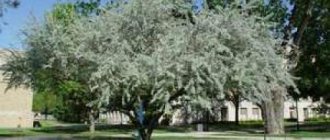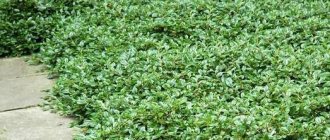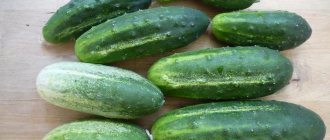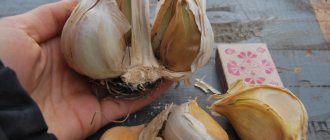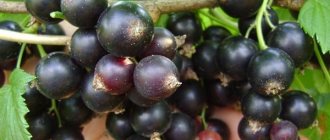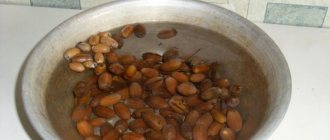Growing oak is a fairly lengthy and responsible process. Many people want to have a powerful and beautiful tree in their yard. Let's consider how you can plant this tree, how long the oak grows, the possible benefits and harm from it on your own site.
An oak is a large tree with many leaves and a strong trunk. Its fruits, acorns, contain a sufficient amount of useful microelements and are pasture for wild animals.
The natural habitat of oak is considered to be in the Northern Hemisphere with a temperate climate.
Planting material
Let's look at how to plant an oak tree from a seedling on a plot. To obtain a strong plant, an acorn or cuttings can be used as planting material. From an acorn it will take several years longer to grow.
The roots on the cuttings should be sprouted to the appropriate size so that they can painlessly gain a foothold in a new place. But there are no guarantees that it will take root.
There is a better chance of growing a tree from an acorn. This method is preferred. In the first years the plant develops faster, then the process slows down.
Features of growing oak
Growing oak at home is possible in several ways: from acorns, green cuttings, or through ready-made seedlings purchased from garden stores or specialized nurseries.
Let's consider the features of germinating acorns and planting oak seedlings.
Growing oak seedlings from acorns
1). Where can I get acorns?
- You can collect acorns yourself in the fall, under the oak tree, when they fully ripen and fall to the ground. In this case, acorns are planted in the ground immediately in the fall or left until spring, observing certain storage conditions (discussed below).
- The second option is in the spring (after the snow melts) to look under the oak tree for already sprouted (or sprouted) acorns. The collected sprouted fruits must be immediately planted in the ground or stored for a short time in moistened sand.
2). How to prepare acorns for planting?
- In order to germinate acorns yourself, it is important to collect high-quality planting material. If acorns are collected in the fall, it is better to do this in dry weather, after they have completely ripened. In a fully ripe acorn, the cap peels off easily; it serves to protect the fruit from damage.
- The fruits must be large, whole, without rot or other damage (cracks, gnaws). Viable acorns can be immediately planted in the ground. It is practiced to plant directly in open ground or in a container for germinating seedlings and then transplant them to the site.
- To determine the viability of acorns, you can look at their “contents”. Living fruits are yellow inside with a clearly marked embryo, while dead fruits have a dark core.
3). How to store acorns?
- If you plan to store acorns, after collecting they are left to dry at room temperature for about 1-2 weeks. After drying, the acorns are stored in a cool (0-+20C) place with a high level of humidity. A cellar or refrigerator (in a container with sand) is suitable for this. You should not store acorns for more than 1 year, as they quickly lose their viability.
- You should not store acorns in a sealed bag or completely closed container - there is a high probability of their death. During storage, it is advisable to periodically remove the acorns and inspect them for mold. If this appears, the acorns should be washed, dried and placed in the refrigerator again.
- If acorns look darkened and dry after storage, they are unlikely to be suitable for planting. To determine the quality of planting material, you can use water: when soaked, dry fruits float, and viable ones sink to the bottom.
- Another option for winter storage of acorns is to bury the collected fruits on the site, in the ground, to a depth of 20-25 cm. Mark the storage location and cover it with waterproof material.
Planting oak acorns
1).When to plant acorns?
- Acorns can be planted immediately in a permanent place (in the garden) or seedlings can be pre-germinated and then planted on the site. The easiest and easiest way is to plant acorns directly in open ground, in the garden.
- Planting acorns can be done in spring or autumn. When planted in autumn (immediately after harvest), acorns undergo natural stratification in order to “demonstrate” a healthy and hardened sprout in the spring. Acorns are planted in the garden in the fall about 1 month before the first frost.
- When planting in spring, you need to wait until the soil has completely warmed up.
2). How to plant acorns?
- To prevent rotting or, conversely, over-drying of acorns (during thaws), the fruits are buried 7-10 cm into the ground during autumn planting. When planting in spring, it is enough to deepen the acorns by 4-5 cm.
- To prevent acorns from being eaten by animals and from molding, in the event of heavy rainfall, autumn plantings should be covered with any waterproof material.
- Before planting, it is recommended to soak acorns in kerosene to protect the plantings from rodents and other animals that prefer to feast on nut-like fruits.
- Mass planting of acorns in a bed (school) involves placing them in moistened grooves, with an interval of 10-30 cm from each other. The distance depends on the type of oak and the size of the acorn. After planting, the soil is leveled.
- If sprouted acorns are planted, this must be done carefully, since young roots are very brittle and fragile. Sprouted acorns can be planted immediately in open ground or in a container (often a plastic cup is used) for further germination. Soil mixed with a small amount of moss is poured into the container, where the acorn is placed (root down, to a depth of 3-4 cm). The planting container must have drainage holes. Caring for germinating acorns involves regular watering and sufficient light. Grown seedlings (if there are 2-3 leaves) are planted in a large container or transplanted directly into the garden bed.
- Acorns germinate slowly: first the root grows, then the shoot. The first shoots appear only 1-1.5 months after planting.
Planting oak seedlings
- It is easier and simpler to plant purchased 1-2 year old oak seedlings on the site.
- When purchasing and transporting oak seedlings with an open root system, the roots should be wrapped in a damp cloth. Before planting, broken or damaged roots are removed. In the case of a “weak” root system, the shoots are cut by 1/3.
- Purchased oak seedlings with a closed root system have almost 100% survival rate. They are planted in the ground, preserving the natural lump of earth.
1).Which place to land?
- For planting seedlings, choose an open, sunny, spacious place. It is important to remember that oak trees grow like real “giants” and need a large free area. The interval from neighboring plants should be 3-6 meters, and from the nearest building - 3-4 meters. This rule is very important, since the overgrown powerful roots of an adult oak can damage not only the blind area near the building, but also the foundation itself.
- As for the soil, fertile soil with a slightly acidic or neutral reaction is preferable. You can use a soil mixture of sand, peat and turf soil in a ratio of 2:1:2. Adding humus will also help improve the quality of the soil.
2). How to grow seedlings in a school?
- As a rule, annual seedlings require subsequent replanting to a permanent place. Transplantation stimulates the development and branching of the root system of seedlings.
- It is best to replant an annual seedling in the spring, so that if the root is damaged, it has time to fully recover before the buds open.
- The seedlings are transplanted into moist nutrient soil. The first days after planting, the seedlings will “sick” and adapt to new environmental conditions. Then the plant will fully recover and begin to develop.
- Seedlings are planted in furrows with an interval of 15-20 cm between plants.
- In the fall, strong and well-developed seedlings from the school are transplanted to a permanent place. Weak specimens are left to grow in the school for another year.
3). How to plant seedlings in the ground?
- Planting holes are prepared in advance, 2-3 weeks before planting. The depth of the pit is about 50 cm, the diameter is twice as large. When preparing a planting hole, the top (fertile) layer of soil is removed and set aside. A 10-20 cm drainage layer is laid at the bottom of the dug hole, then a mixture of fertilizers mixed with the top layer of soil (removed earlier) is poured. For fertilizers, it is recommended to use double superphosphate (1.5-2 kg), wood ash (1 kg), compost (5 kg), rotted manure (5-6 kg), potassium chloride and potassium sulfate (60-70 g each).
- When planting, the root collar of an oak seedling should be located several centimeters above ground level.
- After planting, the soil around the seedling is compacted and the tree is watered abundantly. Then the tree trunk circle is mulched with mowed grass, compost or humus.
Planting an acorn
It is believed that it is easier to grow a tree from an acorn, even if it takes more time. It is necessary to find a healthy mother plant tree. In the fall, we select several dozen dry, ripe acorns and place them in prepared fertilized soil in disposable plastic cups.
There should be soil 3 cm thick above the acorn. Be patient and constantly moisten the soil. It shouldn't dry out. After the sprouts appear, you need to handle them carefully.
As the oak grows quickly, it will soon need to be transplanted into a large pot. In the first 10 years, the plant growth rate can remain up to 35 cm per year. Further growth slows down.
Preparing the acorn
In order for a gardener to grow oak at home, he must choose the right fruit. During the assembly of oak acorns, it is necessary to ensure that they are intact. Brown fruits with a greenish tint are ideal for planting. However, only those specimens that are easily separated from the cap, which performs an exclusively protective function, are selected for germination.
After collecting the material, empty samples must be taken. To do this, acorns are poured into water and their condition is monitored. Those that will remain afloat and will not sink can be thrown away. In such specimens there is either mold or rot inside.
Those acorns that have passed the test are dried and stratification begins.
Germination
When the acorns are finally dried, they must be germinated using the stratification method. To do this, the fruits are placed in a plastic bag and sawdust and moss are added to it. The bag is tightly closed and stored for about 90 days in a cool place. For example, in the cellar or in the refrigerator. During this time, you should regularly open the bag to let in some oxygen.
In addition, you need to carefully monitor the humidity. In conditions of high humidity, acorns will begin to rot. However, if optimal conditions are provided, after 3 months they will begin to germinate. The next stage is planting the sprouts in the ground.
Planting
To plant sprouted acorns, you need to prepare plastic cups with a diameter of about 5 cm. The first step is to sort the fruits from rotten and unsprouted specimens. After this, the roots are carefully placed in cups with soil, which is collected near the “parent” oak tree.
At first, seedlings planted in cups are watered abundantly. To allow excess liquid to flow out, small holes are made in the containers. The roots need to be planted in open ground after they have finally formed a rhizome. If you plant young roots in the ground without waiting for them to strengthen, the plants will be eaten by rodents.
To plant an oak tree, you need to make sure it is ready to be transplanted. To do this, you need to monitor its condition. If the height of the seedling is 15 cm, and the roots look strong and healthy, then you can begin the planting process. Most often this is done in the fall.
Selecting a place to plant oak
This tree is unpretentious to the soil of the middle zone. However, for best results, oak planting should take place in soil saturated with nutrients.
It is important not only to initially develop the growth of the seedling, but also to continue its intensity. Why do they take soil from the place where the mother tree grows?
When this is not possible, you can buy fertile peat in specialized gardening stores. The soil should be moist, but excess water can harm the root system.
Types of oak and places of their distribution
There are many varieties of oak, each continent has its own type. For aesthetic purposes of landscape design, the following types are mainly used:
Leaves and flowers of pedunculate oak.
- English oak;
- sessile oak;
- red oak;
- Mongolian oak;
- chestnut oak, and others.
As we can see, natural zoning binds this type of flora to fertile soils, with moderate water and temperature balance. For example, it cannot be found in Australia, Africa, or Antarctica.
Species differences lie in the color and shape of leaves, chestnuts, the texture of the bark and crown of the tree. Consequently, pedunculate oak has shiny green and even yellowish leaves. The tree trunk is covered with grey-brown, cracked bark. Grows in Europe. Sessile oak has leaves with a pale green color, chestnut green. Grows in European countries. Red oak is characterized by dark green to brown-brown leaves, smooth gray bark, and brown-brown acorns. The habitat of red oak extends to temperate latitudes. Mongolian oak has dense, light green leaves, light brown acorns, and gray bark. Grows in the countries of the Far East. Chestnut oak has gray bark, dark green leaves and a grayish acorn. This tree is not only broad-leaved, but also evergreen.
Life span of oak
Can you imagine how long it takes an oak tree to grow? The average lifespan of such a tree growing in urban environments is up to 400 years. There are “historical” trees that have been growing for more than 2 thousand years. Their trunk diameter reaches 4 meters.
Japanese quince: description of the plant, features of planting and care. 100 photos and videos of applications for decorating an ornamental garden
Where cherries grow - conditions for the maintenance and growth of the tree. Tips for choosing a place on the site and choosing neighbors for cherries (145 photos)
- Poplar tree: description of the main types and beneficial properties of the tree. Tips for choosing a place for planting and care features (110 photos and videos)
As you understand, when you decide to plant an oak tree, you are making a decision for many future generations of your descendants. If you choose the right place, you can leave a living trace of yourself after your own death.
Oak, botanical certificate
- Oak is a well-known perennial deciduous plant belonging to the Beech family.
- The natural habitat of oak is considered to be regions of the northern hemisphere of the earth with a prevailing temperate climate.
- Oak trees are easily recognized by their characteristic lobate leaves and nut-shaped fruits called acorns. However, there are varieties of oak with a single leaf blade, unusual for our region. In addition, there are also shrubby forms of oak, not exceeding 2-3 meters in height.
- Some varieties of oak are evergreens, the leathery leaves of which remain on the tree for several years.
- Massive bending oak branches form a huge “tent”, providing shade and coolness on hot days.
- The oak tree begins to bear fruit only after 15, and sometimes even 60 years. The lighter and more open the area where the oak grows, the earlier the fruits begin to appear. Acorns of different types of oak differ in size, color and shape. They can be elongated or flattened, small or large, light brown or dark, cinnamon-colored. Acorns ripen in the fall (September - October).
- Most oak species grow slowly but for a long time, reaching large sizes and a dense, wide crown. The average age of long-lived oaks is 200-300 years. Oak trees have been recorded that are over 2000 years old.
- The majestic perennial can reach a height of 50 meters, while the girth of the trunk will be about 6-7 meters. Moreover, it is believed that until the age of 80, oak grows intensively in height, and after this age period - in width.
- The bark of young oak plants is smooth, with a slight glossy coating. With age, the bark becomes significantly rougher and cracks.
- The flowers of the perennial are small, unisexual, and have the appearance of the so-called. "earrings". The flowering of the tree begins approximately in April-May, depending on the region.
- The tree's roots, given the impressive size of most oak varieties, are powerful, branched and deep.
- Oak is a light-loving plant that prefers high-quality soil composition. Mature trees easily tolerate frost and drought and require virtually no special care.
Oak, interesting facts
- The oak tree is one of the most majestic and impressive long-lived trees.
- The ancient Romans considered centuries-old oak trees to be another wonder of the world and compared their age with the age of the Universe.
- Among the Slavic peoples, the oak symbolized one of the main trees of the universe, the so-called. “World Tree”, a model of the relationship between the Universe and man.
- The ancient Greeks considered oak a symbol of longevity.
- Oak is a favorite plant for many poets, folklorists and composers.
- In France there is a huge oak tree, 2 centuries old, in the hollow of which there is a room for visitors.
- Virginia oak wood is very durable and does not lose its properties even in water. Ships made from this type of oak were able to reflect even cannonballs from their sides.
- Currently, many varieties of oak are widely used in landscaping parks, squares, and private areas.
Advantages and disadvantages of oak at home
The decision to plant such a tree must be approached responsibly. Before planting an oak tree on your property, you need to weigh the pros and cons. After all, it will take up a lot of space.
The tree has dense foliage, which provides great shade. Nothing grows near it. It has a powerful root system that can destroy the foundation of a building built nearby. You can use this to your advantage.
A strong root system can prevent soil movement. Taking advantage of the shade of a tree, you can put a gazebo under it and relax on a hot summer day.
The best oak varieties
In northern latitudes, in temperate and tropical climates, about 600 varieties of this plant grow. For the purpose of landscaping garden plots, parks and city alleys, low-growing varieties of common (pedunculate) oak are used. These are Asplenifolia, Fastigiata, as well as Fastigiata Koster and Concordia. The main characteristic features of these varieties are:
- height - from 15 to 30 meters;
- crown - spreading;
- leaves are notched, dense, rich dark green.
The second most popular is red or northern oak. It is called so due to the characteristic color of the leaves. In the spring, when they bloom, they have a reddish tint, in the summer they are completely green, and in the fall they become red, crimson, even brown. The Aureus variety enjoys primacy.
Oak leaves
Oak replanting
Before replanting an oak tree, you need to do the following:
- Prepare an area with a diameter of 20 m, which is what an adult tree will need.
- In the center we dig up an area with a diameter of 1.5 m to enrich it with oxygen.
- We dig a hole in the middle of the site, allowing us to freely place the root system of the seedling, and fertilize it with humus.
- We take the seedling out of the pot along with the soil and place it in the hole, cover it with soil and compact it.
- Fill the landing site well with water.
- We lay mulch around the seedling to conserve moisture.
Growing figs at home - tips and instructions for care and maintenance indoors (155 photos and videos)
- Norway spruce - general information, description, properties, characteristics and cultivation features. 105 photos of using spruce in landscape design
Why cherry trees dry out after flowering - searching for the reason and tips on how to save the tree and harvest (125 photos)
Conclusion
In this text we looked at how oak grows. It is clear that this is a fairly serious tree. Whether to plant it on your personal plot is up to everyone to decide.
However, if a person’s ambitions and the size of the plot allow this to be done, then a properly planted oak tree under proper supervision will be a wonderful decoration for a private yard.
Tree care
Chestnut oak leaves.
It is not easy to plant an oak; like any plant, it needs care. Decorative pruning or artificial formation of the trunk - it all depends on personal aesthetic needs.
In addition, oak needs constant lighting. Therefore, a young tree sprout should not be in the shade of large trees or grass. You should regularly remove weeds and weed the area where the seedling grows. Additional moisture and fertilization are necessary in the early years and during the dry season. It is necessary to constantly fluff up the soil. In addition, it is important to prevent any diseases of the young shoot.
It is less resistant to powdery mildew, which can damage young trees. This fungal disease affects both the leaves and stems of the tree and is transmitted by fungal spores. To prevent this disease, it would be good to treat the young seedling with a solution of copper sulfate. And if there is a clear threat, a solution of foundationalose and colloidal sulfur is used.
In conditions of excessive moisture, there is a place for mulching the tree trunk area with wood shavings or peat. The same actions are carried out in the winter, for frost resistance of the tree trunk. It is better to insulate young trees by treating them with garden varnish and additionally wrapping them with fabric materials. In addition, you should protect the oak tree from harmful insects. These can be oak longhorn beetle, moth, leaf roller. For prophylaxis, solutions of Decis and Kenmix are used.
Photo of oak planting
Benefits of oak in the garden
The main factor that speaks in favor of planting oak on a site is its appearance. Rich, beautiful, creates an atmosphere of family comfort. Your site will stand out noticeably from others. In addition, oak is quite unpretentious, resistant to wind and frost, and therefore suitable for cultivation in many regions.
Oak bark is a popular healing agent in many folk recipes. It is used for rinsing the mouth and treating gums, used in cosmetology and anti-inflammatory decoctions are made from it.
People who have an oak tree growing on their property note its positive energy and assure: just sit a little near the tree after a hard day, and all adversity fades into the background.
Correct fit
How to plant oak? To plant an oak tree, the hole must be prepared in advance. It is better to do this at least two weeks before planting. In order for the earth to settle, the hole must be watered abundantly several times.
The soil mixture is prepared from:
- Earth from the garden - part 1
- Humus - 2 parts
- Leaf soil from under oak - 2 parts
- Fertilizer type AVA for 3-5 years - one handful
- Sand - 1 part
This recipe will allow the tree to quickly take root and provide it with food for several years.
Planting a finished seedling from a pot into open ground is done as soon as possible after purchase:
- The seedling in the pot is watered 2 hours before the intended planting. This procedure will help you remove it from the landing container without damage.
- A 10 cm layer of drainage is placed at the bottom of the planting hole. This can be broken brick or just crushed stone.
- The planting hole is filled with prepared soil
Together with a lump of earth from the pot, the seedling is transplanted into the hole. When planting in open ground, the soil level remains the same as in a pot. After removing the plant from the pot, you can shake off the soil a little.
The soil around the roots is compacted using a fist or a wooden mortar. Soil trampling cannot always be controlled. In this process, you can overdo it a little and damage the delicate roots of the plant that provide it with nutrition.
It is better to plant seedlings from under oak trees immediately after digging them up. The pit is prepared in the same way as the previous method.
Acorns collected in the fall, or better yet in the spring, are planted to a depth of 5-7 cm.
Watering any plantings must be done daily. Tender sprouts should not be overwatered or dried. The soil should be slightly moist, but not wet.
Expert opinion
Yulia Yurievna
I have a large garden and vegetable garden, several greenhouses. I love modern methods of cultivating plants and mulching the soil, and I share my experience.
Ask a Question
Reproduction methods, cultivation
An oak tree can propagate by cuttings or by planting acorns. Cuttings taken from adult individuals practically do not take root. For this reason, the material is taken from annual plants. You need to have time to plant them from June to July.
If you want to have a garden oak tree on your property, then the easiest way to grow it is from an acorn. The fruits are collected from September to October. Acorns must be planted immediately after harvesting, otherwise they will dry out and will not be able to take root.
If autumn turns out to be hot, then the fruits should be watered. To protect against rodents, the beds are covered with spruce branches. To properly plant acorns, you must follow all recommendations regarding this process.
Where is the best place to plant oak?
On a small to medium-sized plot, oak can be planted in a seating area at the edge of the lawn. A fail-safe option is near the fence, from the inside or outside, optimally in the alignment of neighboring windows.
If the plot size is 30-40 acres or more, you can create driveway alleys and wind protection for the garden on the north side. Buy oak seedlings 180 cm high for 500 rubles. Another option is to plant 2-3 oak trees using the so-called bouquet planting. Bouquet planting is planting 2-3 trees at a very close distance, while they do not grow vertically, but deviate in the form of a bouquet.
Oak trees can be safely planted as a hedge. These seedlings are about 10 years old.
Do not plant oaks in the shade of houses or other trees. Oak is light-loving; in the shade, seedlings grow poorly and are affected by powdery mildew.
Types and varieties
There are more than six hundred varieties of oak in the world, but not all of them are suitable for growing on the site. If you want a century-old tree to decorate your garden, take a look at these options:
- White oak . It grows up to 25 meters, in exceptional cases – up to 40. It has a gorgeous crown with large leaves that change color depending on the time of year. In summer they are soft green, in autumn they are crimson. This variety is not very frost-resistant, so it can only be planted by those who do not experience severe frosts.
- Swamp oak . An impressive tree that, like the previous variety, grows to a height of 25 meters. It has a pyramidal crown and wide leaves that vary in color from soft green to rich crimson. Thanks to this, he always looks very impressive. But there is a nuance: it needs moist soil
- Holm oak . This is an option for those who live in areas with severe frosts. A very strong and frost-resistant variety, which is in no way inferior in beauty to its predecessors. Its leaves are curly and patterned, so this tree is a real decoration of the site.
- English oak . Suitable for owners of huge plots - unfortunately, this beauty cannot be grown on six acres. It grows up to 50 meters in length and can grow for up to 1000 years. It has a rich crown with dark green leaves. It looks truly impressive.
If you have a small plot, and after looking at the list of these giant oak trees, you sighed heavily and decided to abandon this idea, do not despair. Pay attention, for example, to the “Compact” variety. This is a dwarf tree, which, despite its miniature size, looks impressive.
English oak
What does an oak tree need and where to plant it?
Of all the variety of species, only holm oak is distinguished by its ability to grow in the shade.
In other characteristics, all oak giants or babies are similar:
- Love the sunshine
- Prefer fertile soil
- Easily tolerate drought
- They love space
- Prolonged stagnation of water at the roots is undesirable
- Soil acidity should be close to neutral
When choosing a place for planting, it is necessary to take into account growth characteristics. The slow growth of an oak seedling should not mislead the gardener.
If the tree is comfortable in a new place, it will soon spread its powerful roots over long distances. And then great damage will be caused to buildings and paths. Strong roots destroy the foundation of the house and buildings, paths and pools.
Oak seedlings for planting
This feature of the tree makes it necessary to plan planting away from any structures.
In the far corner of the garden, the oak tree will not disturb anyone, and under its canopy it is good to relax in a hammock in the summer. And how the children will rejoice if they are allowed to make their own secluded corner on the branches.
Species with a wide dome-shaped crown provide a lot of shade, so only shade-loving and hardy plants survive near such a tree.
If there is no room on the site for a large oak tree, but you still have the desire to grow it, then to do this you need to choose a specimen with a neat round or conical crown. Such a tree will be able to act not only as a soloist, but will also keep company with other deciduous plants.
Oak does not tolerate proximity to conifers well. Spruce loves acidic soils and, scattering needles around itself, creates comfortable conditions with its help. The oak tree will not grow in such conditions.
When planting varieties such as:
- White oak
- Swamp oak
it is necessary to take into account their instability to spring frosts. Young shoots can be damaged even by slight return frosts.
The correct choice of location and creation of comfortable conditions will ensure rapid growth and development of the tree.
